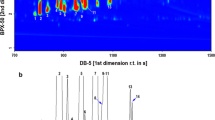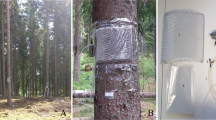Abstract
Volatiles from fresh bark of black cottonwood, Populus trichocarpa; trembling aspen, P. tremuloides; paper birch, Betula papyrifera; bigleaf maple, Acer macrophyllum; red alder, Alnus rubra; and Sitka alder, Alnus viridis, were collected on Porapak Q and subjected to coupled gas chromatographic–electroantennographic detection analyses by utilizing the antennae of several scolytid beetles (Dendroctonus pseudotsugae, D. rufipennis, D. ponderosae, Ips pini, and Dryocoetes confusus). Among the antennally active volatiles identified by coupled gas chromatographic-mass spectroscopic analysis were frontalin, 1,5-dimethyl-6,8-dioxabicyclo[3.2.1]-octane, in the two Alnus species and conophthorin, (E)-7-methyl-1,6-diox-aspiro[4.5]decane, in the other four species. Field trapping experiments demonstrated that conophthorin had a significant disruptant effect on the response to a pheromone-host kairomone blend by both Dendroctonus pseudotsugae and D. ponderosae. Our results, and the recent identification of other scolytid pheromones in various tree species, pose major questions regarding the evolution and ecological roles of these semiochemicals, including the possibility of Batesian mimicry by the beetles. They also suggest a need for comparative studies on the biosynthetic pathways for these compounds.
Similar content being viewed by others
REFERENCES
Aldrich, J. R., Avery, J. W., Lee, C-J. Graf, J. C., Harrison, D. J., and Bin, F. 1996. Semiochemistry of cabbage bugs (Heteroptera: Pentatomidae: Eurydema and Murgantia). J. Entomol. Sci. 31:172–182.
Arn, H., TÓth, M., and Preisner, E. 1992. List of Sex Pheromones of Lepidoptera and Related Attractants, 2nd ed. International Organization for Biological Control, Montfavet, France.
Atkins, M. D. 1966. Behavioural variation among scolytids in relation to their habitat. Can. Entomol. 98:285–288.
Bakke, A., FrØyen, L. 1977. Field response to a new pheromonal compound isolated from Ips typographus. Naturwissenschaften 64:98–99.
Bates, H. W. 1862. XXXII. Contributions to an insect fauna of the Amazon valley. Lepidoptera: Heliconidae. Trans. Linn. Soc. London 23:495–566.
Bell, W. J. 1990. Searching Behaviour: The Behavioural Ecology of Finding Resources. Chapman and Hall, New York.
Birgersson, G. 1989. Host tree resistance influencing pheromone production in Ips typographus (Coleoptera: Scolytidae). Holarct. Ecol. 12:451–456.
Birgersson, G., Debarr, G. L., De Groot, P., Dalusky, M. J., Pierce, H. D., Jr., Borden, J. H., Meyer, H., Francke, W., Espelie, K. E., and Berisford, C. W. 1995. Pheromones in the white pine cone beetle, Conophthorus coniperda (Schwarz) (Coleoptera: Scolytidae). J. Chem. Ecol. 21:143–167.
Blum, M. S. 1970. The chemical basis of insect sociality, pp. 61–94, in M. Beroza (ed.). Chemicals Controlling Insect Behavior. Academic Press, New York.
Blum, M. S. 1996. Semiochemical parsimony in the Arthropoda. Annu. Rev. Entomol. 41:353–374.
Borden, J. H. 1982. Aggregation pheromones, pp. 74–139, in J. B. Mitton and K. B. Sturgeon (eds.). Bark Beetles in North American Conifers: A System for the Study of Evolutionary Biology. University of Texas Press, Austin.
Borden, J. H. 1985. Aggregation pheromones, pp. 257–285, in G. A. Kerkut and L. I. Gilbert (eds.). Comprehensive Insect Physiology, Biochemistry and Pharmacology, Vol. 9. Pergamon Press, New York.
Borden, J. H., Ryker, L. C., Chong, L. J., Pierce, H. D., Jr., Johnston, B. D., and Oehlschlager, A. C. 1987. Response of the mountain pine beetle, Dendroctonus ponderosae Hopkins (Coleoptera: Scolytidae), to five semiochemicals in British Columbia lodgepole pine forests. Can. J. For. Res. 17:118–128.
Borden, J. H., Huber, D. P. W., Pierce, H. D., Jr., Gries, G., Gries, R., Chong, L. J., and Wilson, I. M. Nonhost volatiles as repellents for conifer-infesting bark beetles. US Patent application submitted December 8, 1997.
Borden, J. H., Wilson, I. M., Gries, R., Chong, L. J., Pierce, H. D., Jr., and Gries, G. 1998. Volatiles from the bark of trembling aspen, Populus tremuloides Michx. (Salicaceae) disrupt secondary attraction by the mountain pine beetle, Dendroctonus ponderosae Hopkins (Coleoptera: Scolytidae). Chemoecology 8:69–75.
Byers, J. A. 1995. Host-tree chemistry affecting colonization in bark beetles, pp. 154–213, in R. T. Cardé and W. J. Bell (eds.). Chemical Ecology of Insects 2. Chapman and Hall, New York.
Byers, J. A., Zhang, Q., Schlyter, F., and Birgersson, G. 1998. Volatiles from nonhost birch trees inhibit pheromone response in spruce bark beetles. Naturwissenschaften 85:557–561.
Dahlsten, D. L. 1982. Relationship between bark beetles and their natural enemies, pp. 140–182, in J. B. Mitton and K. B. Sturgeon (eds.). Bark Beetles in North American Conifers: A System for the Study of Evolutionary Biology. University of Texas Press, Austin.
Dallara, P. L., Seybold, S. J., Francke, W., and Wood, D. L. 1994. The chemical ecology of Pityophthorus Eichhoff (Coleoptera: Scolytidae) in central coastal California, Appendix, pp. Ixviii-Ixix, in D. H. Adams, J. E. Rios, and A. J. Storer (eds.). Annual Meeting of the California Forest Pest Council, Proceedings of the 43rd Annual Meeting. Rancho Cordova, California.
Day, R. W., and Quinn, G. P. 1989. Comparisons of treatments after an analysis of variance in ecology. Ecol. Monogr. 59:433–463.
Deglow, E. K., and Borden, J. H. 1998. Green leaf volatiles disrupt and enhance response to aggregation pheromones by the ambrosia beetle, Gnathotrichus sulcatus (Leconte) (Coleoptera: Scolytidae). Can. J. For. Res. 28:1697–1705.
Dickens, J. C., Billings, R. F., and Payne, T. L. 1992. Green leaf volatiles interrupt aggregation pheromone response in bark beetles infesting southern pines. Experientia 48:523–524.
Fitzpatrick, S. M., Miller, D., Weatherston, I., and McNeil, J. N. 1985. Determining pheromone content of hairpencils from individual virgin males of Pseudaletia unipuncta (Haw.) (Lepidoptera: Noctuidae). J. Chem. Ecol. 11:207–215.
Francke, W., Hindorf, G., and Reith, W. 1978. Methyl-1,6-dioxaspiro[4.5]decanes as odors of Paravespula vulgaris (L.). Angew. Chem. Int. Ed. Engl. 17:862.
Gries, G. 1995. Prospects of new semiochemicals and technologies, pp. 44–47, in S. M. Salom and K. R. Hobson (eds.). Application of Semiochemicals for Management of Bark Beetle Infestations-Proceedings of an Informal Conference. USDA For. Serv. Gen. Tech. Rep. INT-GTR-318.
Gries, G., Nolte, R., and Sanders, W. 1989. Computer simulated host selection in Ips typographus. Entomol. Exp. Appl. 53:211–217.
Guilford, T., Nicol, C., Rothschild, M., and Moore, B. P. 1987. The biological roles of pyrazines: Evidence for a warning odour function. Biol. J. Linn. Soc. London 31:113–128.
Hall, D. R., Beevor, P. S, Cork, A., Nesbitt, B. F., and Vale, G. A. 1984. 1-Octen-3-ol a potent olfactory stimulant and attractant for tsetse isolated from cattle odours. Insect Sci. Appl. 5:335–339.
Harley, P., Fridd-Stroud, V., Greenberg, J., Guenther, A., and Vasconcellos, P. 1998. Emission of 2-methyl-3-buten-2-ol by pines: A potentially large natural source of reactive carbon to the atmosphere. J. Geophys. Res. 103:25,479–25,486.
Jacquin, E., Nagnan, P., and Frerot, B. 1991. Identification of hairpencil secretion from male Mamestra brassicae (L.) (Lepidoptera: Noctuidae) and electroantennogram studies. J. Chem. Ecol. 17:239–246.
Kohnle, U., Densborn, S., KÖlsch, P., Meyer, H., and Francke, W. 1992. E-7-methyl-1,6-dioxaspiro[4.5]decane in the chemical communication of European Scolytidae and Nitidulidae (Coleoptera). J. Appl. Entomol. 114:187–192.
Lindgren, B. S. 1983. A multiple funnel trap for scolytid beetles (Coleoptera). Can. Entomol. 115:299–302.
Perrin, T. E., Rasmussen, L. E. L., Gunawardena, R., and Rasmussen, R. A. 1996. A method for collection, long-term storage, and bioassay of labile volatile chemosignals. J. Chem. Ecol. 22:207–221.
Pierce, A. M., Borden, J. H., and Oehlschlager, A. C. 1981. Olfactory response to beetle-produced volatiles and host-food attractants by Oryzaephilus surinamensis and O. mercator. Can. J. Zool. 59:1980–1990.
Pierce, A. M., Pierce, H. D., Jr., Borden, J. H., and Oehlschlager, A. C. 1989. Production dynamics of cucujolide pheromones and identification of 1-octen-3-ol as a new aggregation pheromone for Oryzaephilus surinamensis and Orysaephilus mercator (Coleoptera: Cucujidae). Environ. Entomol. 18:747–755.
Pierce, H. D., Jr., De Groot, P., Borden, J. H., Ramaswamy, S., and Oehlschlager, A. C. 1995. Pheromones in red pine cone beetle, Conophthorus resinosae Hopkins, and its synonym, C. banksianae McPherson (Coleoptera: Scolytidae). J. Chem. Ecol. 21:169–185.
Rasmussen, L. E. L., Lee, T. D., Roelofs, W. L., Zhang, A., and Daves, G. D., Jr. 1996. Insect pheromone in elephants. Nature 379:684.
Rudinsky, J. A. 1962. Ecology of Scolytidae. Annu. Rev. Entomol. 7:327–348.
Ryker, L. C., and Libbey, L. M. 1982. Frontalin in the male mountain pine beetle. J. Chem. Ecol. 8:1399–1409.
SAS Institute Inc. 1988. SAS/STAT Users Guide, Release 6.03 Edition. Cary, North Carolina.
Schlyter, F., Birgersson, G., Byers, J. A., LÖfqvist, J., and BergstrÖm, G. 1987. Field response of spruce bark beetle, Ips typographus, to aggregation pheromone candidates. J. Chem. Ecol. 13:701–716.
Schroeder, L. M. 1992. Olfactory recognition of nonhosts aspen and birch by conifer bark beetles Tomicus piniperda and Hylurgops palliatus. J. Chem. Ecol. 18:1583–1593.
Shepherd, R. F. 1966. Factors influencing the orientation and rates of activity of Dendroctonus ponderosae Hopkins (Coleoptera: Scolytidae) Can. Entomol. 98:507–518.
Torto, B., Obeng-Ofori, D., Njagi, P. G. N., Hassanali, A., and Amiani, H. 1994. Aggregation pheromone system of adult gregarious desert locust Schistocerca gregaria (Forskal). J. Chem. Ecol. 20:1749–1762.
Werner, R. A., and Holsten, E. H. 1995. Current status of research with the spruce beetle Dendroctonus rufipennis, pp. 23–29, in S. M. Salom and K. R. Hobson (eds.). Application of Semiochemicals for Management of Bark Beetle Infestations—Proceedings of an Informal Conference. USDA For. Serv. Gen. Tech. Rep. INT-GTR-318.
Wilson, I. M., Borden, J. H., Gries, R., and Gries, G. 1996. Green leaf volatiles as antiaggregants for the mountain pine beetle, Dendroctonus ponderosae Hopkins (Coleoptera: Scolytidae). J. Chem. Ecol. 22:1861–1875.
Zar, J. H. 1984. Data transformations. Biostatistical Analysis, 2nd ed. Prentice-Hall, Englewood Cliffs, New Jersey, pp. 236–242.
Zuber, M. 1994. Racemate and enantiomers of ipsidenol for attracting Ips amitinus (Eichh.) (Col., Scolytidae). Anz. Schaedlingskd. Pflanz. Umweltschutz 67:92–93.
Author information
Authors and Affiliations
Rights and permissions
About this article
Cite this article
Huber, D.P.W., Gries, R., Borden, J.H. et al. Two Pheromones of Coniferophagous Bark Beetles Found in the Bark of Nonhost Angiosperms. J Chem Ecol 25, 805–816 (1999). https://doi.org/10.1023/A:1020892700653
Issue Date:
DOI: https://doi.org/10.1023/A:1020892700653




